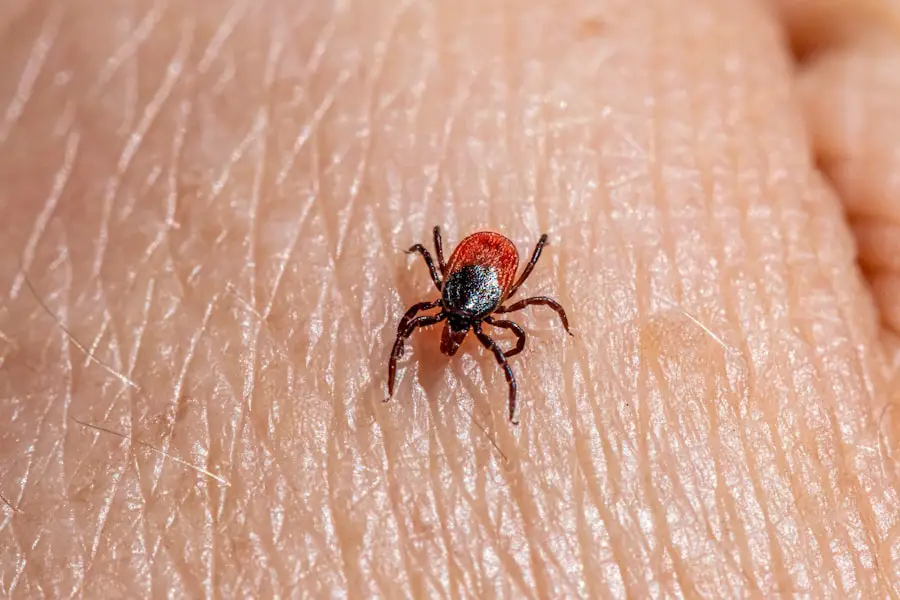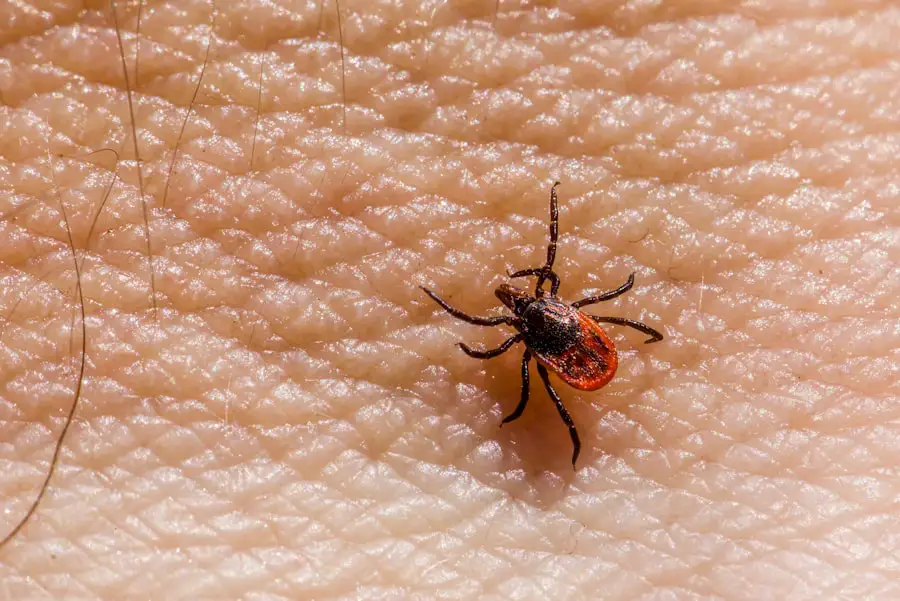As outdoor enthusiasts venture into nature, the allure of hiking trails, lush forests, and serene meadows often comes with hidden dangers, one of which is the presence of ticks. These small arachnids, while seemingly innocuous, can pose significant health risks to humans and pets alike. Tick prevention is not merely a precaution; it is an essential practice for anyone who enjoys spending time outdoors.
Understanding how to effectively prevent tick bites can help individuals enjoy their outdoor activities without the looming threat of tick-borne diseases. Tick-borne illnesses, such as Lyme disease, Rocky Mountain spotted fever, and anaplasmosis, have been on the rise in many regions. The Centers for Disease Control and Prevention (CDC) reports that the incidence of Lyme disease has increased significantly over the past few decades, particularly in the northeastern United States.
This alarming trend underscores the importance of tick prevention strategies. By arming oneself with knowledge about ticks and implementing effective prevention measures, individuals can significantly reduce their risk of encountering these pests and the diseases they carry.
Key Takeaways
- Tick prevention is important for enjoying the outdoors without fear of ticks.
- Understanding the risks of tick bites is crucial for effective prevention.
- Choosing the right clothing can greatly reduce the risk of tick bites.
- Using insect repellent is an effective method for tick prevention.
- Checking for ticks after hiking is essential for preventing tick-borne diseases.
Understanding the Risks of Tick Bites
Ticks are not just a nuisance; they are vectors for various pathogens that can lead to serious health complications. The most well-known tick-borne disease is Lyme disease, caused by the bacterium Borrelia burgdorferi, which is transmitted through the bite of infected black-legged ticks, commonly known as deer ticks. Symptoms of Lyme disease can range from mild to severe and may include fever, headache, fatigue, and a characteristic skin rash known as erythema migrans.
If left untreated, Lyme disease can lead to more severe complications affecting the joints, heart, and nervous system. In addition to Lyme disease, ticks can transmit other diseases such as babesiosis, ehrlichiosis, and tularemia. Each of these diseases presents its own set of symptoms and potential long-term health effects.
For instance, babesiosis can cause flu-like symptoms and may lead to severe complications in individuals with weakened immune systems. Understanding these risks is crucial for anyone who spends time in areas where ticks are prevalent. Awareness of the potential consequences of tick bites can motivate individuals to take proactive measures to protect themselves and their loved ones.
Choosing the Right Clothing for Tick Prevention

One of the most effective ways to prevent tick bites is by choosing appropriate clothing when venturing into tick-infested areas. Wearing long sleeves and long pants can create a physical barrier between ticks and the skin. Light-colored clothing is particularly advantageous because it makes it easier to spot ticks before they attach.
Additionally, tucking pants into socks or boots can further reduce the likelihood of ticks crawling up the legs. Certain fabrics are more effective at repelling ticks than others. For instance, tightly woven materials provide a better defense against tick bites compared to loose-fitting clothing.
Some outdoor apparel brands offer clothing specifically designed for tick prevention, often treated with permethrin, an insect repellent that remains effective even after multiple washes. By investing in such clothing, outdoor enthusiasts can enhance their protection against ticks while enjoying their favorite activities.
Using Insect Repellent for Tick Prevention
| Product | Active Ingredient | Protection Time | Application |
|---|---|---|---|
| Spray | DEET | Up to 8 hours | Directly on skin or clothing |
| Lotion | Picaridin | Up to 12 hours | Directly on skin |
| Wipes | Oil of Lemon Eucalyptus | Up to 6 hours | Directly on skin |
Insect repellents play a crucial role in tick prevention strategies. The CDC recommends using repellents that contain at least 20% DEET (N,N-diethyl-meta-toluamide) for effective protection against ticks. DEET works by interfering with a tick’s ability to detect humans through scent and heat, making it less likely for them to latch onto a person.
Other effective ingredients include picaridin and oil of lemon eucalyptus, both of which have been shown to provide substantial protection against tick bites. When applying insect repellent, it is essential to follow the manufacturer’s instructions carefully. This includes applying the repellent to exposed skin and clothing while avoiding contact with eyes and mouth.
For those who are concerned about chemical exposure, natural alternatives such as essential oils may offer some level of protection; however, their effectiveness may not be as reliable as synthetic repellents. Regardless of the type of repellent chosen, reapplication is necessary after sweating or swimming to maintain optimal protection.
Checking for Ticks After Hiking
After spending time in areas where ticks are prevalent, conducting a thorough tick check is vital for early detection and removal. Ticks often attach themselves in hard-to-see areas such as behind the ears, underarms, and along the waistband. It is advisable to perform a full-body inspection using a mirror or asking someone else for assistance in checking hard-to-reach areas.
In addition to personal checks, it is equally important to inspect pets after outdoor activities. Ticks can easily latch onto dogs and cats during walks or hikes, bringing them into the home where they can pose a risk to humans as well. Regular grooming and bathing can help identify ticks on pets before they have a chance to attach and transmit diseases.
Creating a Tick-Free Zone at Home

Creating a tick-free environment around one’s home is an essential aspect of comprehensive tick prevention. Ticks thrive in wooded areas and tall grasses; therefore, maintaining a well-manicured yard can significantly reduce their presence. Regularly mowing the lawn, trimming shrubs, and clearing away leaf litter can help eliminate potential tick habitats.
Additionally, creating barriers between wooded areas and recreational spaces can further deter ticks from encroaching on residential properties. For instance, installing wood chips or gravel pathways can serve as a buffer zone that reduces contact with tall grasses where ticks are likely to reside. Furthermore, keeping play areas sunny and dry can discourage ticks from settling in those spaces.
Understanding Tick Habitats
To effectively prevent tick bites, it is crucial to understand where ticks are most likely to be found. Ticks thrive in humid environments with ample vegetation, making wooded areas, tall grasses, and leaf litter prime habitats for these pests. They are often found in areas where deer or other wildlife frequent since these animals serve as hosts for ticks during their life cycle.
Ticks are most active during warmer months, particularly from spring through fall when temperatures rise above 40°F (4°C). However, certain species can remain active even during milder winter months if conditions permit. Understanding these seasonal patterns can help individuals plan their outdoor activities accordingly and take necessary precautions during peak tick season.
Removing Ticks Safely and Effectively
If a tick is discovered attached to the skin, prompt removal is essential to minimize the risk of disease transmission. The CDC recommends using fine-tipped tweezers for safe removal. Grasping the tick as close to the skin’s surface as possible allows for a more effective extraction without leaving parts of the tick embedded in the skin.
Once removed, it is important to clean the bite area thoroughly with soap and water or an antiseptic solution. Monitoring the bite site for any signs of infection or unusual symptoms in the following weeks is also crucial. If symptoms such as fever or rash develop after a tick bite, seeking medical attention promptly can lead to early diagnosis and treatment of potential tick-borne diseases.
Vaccination and Medication for Tick Prevention
While there is currently no widely available vaccine for Lyme disease for humans in the United States, there are vaccines available for pets that can help protect them from certain tick-borne diseases. For instance, canine Lyme disease vaccines are designed to reduce the risk of infection in dogs that may be exposed to infected ticks during outdoor activities. In addition to vaccination options for pets, some medications can help prevent tick-borne diseases in both humans and animals.
For example, prophylactic antibiotics may be prescribed after a high-risk tick bite if certain criteria are met. Understanding these medical options can provide an additional layer of protection against tick-borne illnesses.
Educating Yourself and Others about Tick Prevention
Education plays a pivotal role in effective tick prevention strategies. Individuals should familiarize themselves with local tick species, their habitats, and peak activity times specific to their region. Community awareness programs can also help disseminate information about tick prevention methods and encourage safe practices among outdoor enthusiasts.
Sharing knowledge about ticks with family members and friends fosters a culture of awareness that extends beyond individual efforts. Schools and community organizations can host workshops or informational sessions on tick prevention strategies to educate children and adults alike about the importance of protecting themselves from these pests while enjoying outdoor activities.
Enjoying the Outdoors Without the Fear of Ticks
The fear of ticks should not deter individuals from enjoying nature’s beauty and engaging in outdoor activities. By implementing comprehensive tick prevention strategies—such as wearing appropriate clothing, using insect repellents, conducting thorough checks after outdoor excursions, creating tick-free zones at home, understanding tick habitats, safely removing ticks when necessary, exploring vaccination options for pets, and educating oneself and others—individuals can significantly reduce their risk of tick bites and associated diseases. With proper knowledge and proactive measures in place, outdoor enthusiasts can confidently explore hiking trails, picnic in parks, or simply enjoy their backyards without the constant worry of encountering ticks.
Embracing these practices allows individuals to fully appreciate the wonders of nature while safeguarding their health against potential threats posed by these tiny yet impactful creatures.
If you’re planning a hiking trip and want to avoid ticks, it’s important to be prepared. One helpful article to check out is 5 Must-Have Minimalist Travel Backpacks for Spring Adventures 2025, which provides tips on choosing the right gear for your outdoor excursions. Remember to also pack insect repellent and wear long sleeves and pants to protect yourself from ticks. Stay safe and enjoy your hike!
FAQs
What are ticks and why are they a concern while hiking?
Ticks are small, blood-sucking parasites that can transmit diseases such as Lyme disease, Rocky Mountain spotted fever, and others. They are commonly found in wooded and grassy areas, making them a concern for hikers.
How can I avoid ticks while hiking?
To avoid ticks while hiking, you can take several precautions such as wearing long sleeves and pants, using insect repellent with DEET, staying on the center of trails, and avoiding tall grass and brush.
What should I do if I find a tick on me while hiking?
If you find a tick on you while hiking, use fine-tipped tweezers to grasp the tick as close to the skin’s surface as possible and pull upward with steady, even pressure. Clean the bite area and your hands with rubbing alcohol, an iodine scrub, or soap and water.
How can I protect my pets from ticks while hiking?
To protect your pets from ticks while hiking, you can use tick prevention products such as collars, spot-on treatments, or oral medications. Additionally, check your pets for ticks after hiking and remove any ticks promptly.
What are some signs and symptoms of tick-borne illnesses?
Signs and symptoms of tick-borne illnesses may include fever, chills, headache, fatigue, muscle and joint aches, and a rash. If you experience any of these symptoms after being bitten by a tick, seek medical attention promptly.
